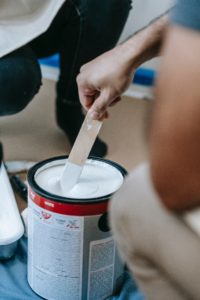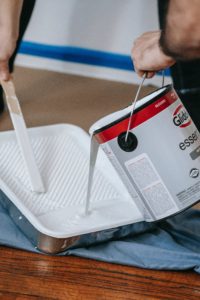These days there are so many options available for paint that it can be completely overwhelming trying to decide which one will be the best fit for your needs. We will break it down for you, so you can understand what to look for in a coating.
The main function of an architectural coating it to protect the integrity of the substrate. Whether that is metal, wood, drywall, cement, etc. the purpose is to ensure the lifespan of whatever it is going on top of.
Every kind of paint coating is comprised of four basic components:
- Pigments: Finely ground material (organic, or inorganic) that give the paint it’s colour and hiding coverage capacity. They also assist in protecting the substrate from UVA/UVB damage. A common pigment found in most coatings is Titanium Dioxide, which provides the white colour.
- Binders: Are what holds the pigments in place and holds all the ingredients of the paint together. They are made from natural or synthetic resins, including oils, acrylics, melamine, polyurethanes, epoxy, etc. They are sometimes referred to as the catalyst, or vehicle.
- Liquids: These provide the “workability” of the coating, meaning how easy it will be to apply to the substrate. Which liquid is used determines the “open-time” (how long the coating stays wet before starting to dry) For many oil-based paints the liquid used is mineral spirits, which take longer to dry often offering a longer open-time which will usually allow for a more forgiving workability. Latex paint is typically a water-based coating, and will allow for faster recoat, but will shorten the open-time, meaning you will need to work a bit faster with it.
- Additives: These ingredients can enhance the inherent properties of the liquid ingredients and will determine the overall performance of the coating. A few examples would be: mildewcide will prevent mold from forming on the surface of the paint film, a preservative will keep your product from spoiling in storage, levelling agents will give the paint the ability to settle while drying and prevent those unsightly brush strokes or roller marks.
These ingredients, and the quality of them have critical roles that they play in every type of coating’s performance, as well as affecting the cost.
Determining the Quality
When trying to understand the quality of a coating, looking at the volume of solids, as well as the titanium dioxide content will be a strong indicator for how good the coating is. This information is available on the product’s Material Safety Data Sheet (MSDS) and the Technical Data Sheet (TDS) which you can find on the coating company website, or in store where the paint is being sold.
- Volume of Solids:
Higher qualities of paint will have higher percentages of pigments and binders (which is what “Volume of Solids” refers to) and will reflect lower percentages of liquids. What this means is that the coating will be stronger and have a better hiding ability through a thicker paint film. A higher quality paint will have 35-50% volume of solids, and 45-50% of the liquid agent.
Can also be referred to as “Solids by Volume”
- Titanium Dioxide Content:
This pigment ingredient is what gives lighter paint colours the ability to cover a dark coloured substrate. A higher percentage reflecting 20-25% of titanium dioxide will mean less coats will be needed to cover a dark colour. It is important to note that a lower quality of paint will contain pigments known as “Extenders”. These are referred to as pigments and are primarily made up from mica, clay, and silica. These extenders will increase the volume of solids percentage, while not significantly improving the hiding ability, or strength of the coating. This is done to keep the cost of the product down and add bulk to the paint.
Perhaps you have found an excellent bargain and want to mitigate the cost of the project by choosing the lower grade, but attractively priced product. This can be a high risk move for a few reasons:
- The coating may deteriorate rapidly only offering a very short lifespan for the coating, meaning you will need to re-paint sooner than anticipated, costing you more in the long run.
- The coating may fail. Not bonding properly to the surface can result in a labour-intensive cleanup as well as cause difficulty for another coating to hide and adhere to. You may even need additional products to remedy the effects of the failed coating.
- The coverage may be so poor that you need to apply many coats, causing you to have to buy more of the product, costing you more than anticipated as well as spend much longer on the labour.
Better quality ingredients in the coating will typically reflect a higher cost on the product. While this is usually an indication that the paint is a higher quality, it can also reflect factors unrelated to the actual quality of the paint. A company may pass the cost of marketing and logistics onto the customer driving up the price of a lesser quality product. Utilizing the knowledge gained above, you can refer to the products MSDS and TDS to investigate further and have the confidence to decide if the product truly reflects the price point and is right for your project.
If you are still uncertain you can always rely on your trusted painting professional, like us at Casanova Painting. If you are anywhere in the lower mainland, we offer FREE quotes, which includes us coming to the project site where we will go through our product recommendations with you in detail, ensuring you get the best result for all your painting, and staining projects!



